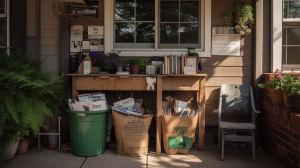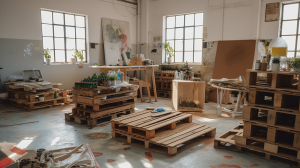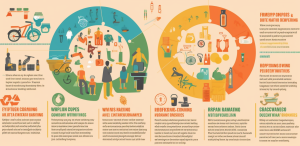Introduction: Understanding Recycling and Upcycling
Understanding the nature of recycling and upcycling is critical in the modern age where the need for sustainability has moved to the forefront of global discourse. At base, recycling is the process of converting waste materials into new materials and products. Recyclable items are taken to a recycling plant where they are processed to create new products. This can involve a wide variety of techniques depending on the type of material being recycled. For instance, a plastic bottle could be recycled into shopping bags, conserving natural resources, and reducing the amount of waste that ends up in landfills. The recycling process reduces greenhouse gas emissions as well since it uses less energy to repurpose recycled material compared to the process of creating new raw materials. However, it is important to note that certain materials are difficult to recycle, making it vital for recycling services to differentiate between the two types of waste.
Meanwhile, upcycling is the process of transforming waste materials or old products into new, useful items of higher quality or environmental value. The original form is retained, but the item is repurposed, resulting in a new item with a different function or aesthetic. For instance, an old jar may be upcycled into a decorative lamp, or old jeans repurposed into a trendy tote bag. Upcycling involves creativity and can also involve a wide variety of techniques based on the item being upcycled. Comparatively, upcycling reduces waste even more significantly than recycling as it completely avoids the energy-intensive process of breaking down materials and recreating them.
Therefore, addressing the difference between upcycling and recycling, upcycling might be better for the environment since it tends to require less energy and creates less emission. By incorporating upcycling into your life and making the most of the materials available, sustainability is made not only practical, like recycling, but also highly creative. Still, there shouldn’t be a competition between upcycling vs recycling, rather, both should be seen as complementary efforts on the path to a greener planet.
The Basic Concept: Recycle and Upcycle
The basic concept of ‘Recycle and Upcycle’, as the phrase suggests, revolves around the principle of reusing and repurposing of old materials in order to minimize waste.
 The process of recycling involves taking waste, typically items that would otherwise be wasted, and transforming them into raw material that can then be used to create something new, whereas upcycling involves taking an item that is no longer in use and creatively repurposing it to give it a new life, hence transforming it into something new and useful.
The process of recycling involves taking waste, typically items that would otherwise be wasted, and transforming them into raw material that can then be used to create something new, whereas upcycling involves taking an item that is no longer in use and creatively repurposing it to give it a new life, hence transforming it into something new and useful.
The difference between recycling and upcycling largely lies in the methods and the end result: recycling takes objects like glass jars or old t-shirts and reduces them down to their basic materials, which are then used as a base for new products, whereas upcycling reuses these items in their current state to create a new product without breaking them down. In terms of practicality and creativity, recycling is a form of waste management that is practical, and council-run recycling schemes are most commonly used, while upcycling can also be a fun and meaningful way to repurpose the item, often termed as highly creative.
One of the most prominent examples of upcycling can be seen in the fashion industry, with many brands that upcycle old materials to create sustainable and unique products. The term upcycling embodies the concept of ‘waste not, want not’, promoting sustainability by diverting waste from the recycling bin, such as a glass recycling bin, or landfill, and moving it back into the consumer cycle. When one wants to upcycle, say, an old t-shirt, they might transform it into a tote bag or a rug, increasing its lifespan.
The process of upcycling involves taking such items, retaining the object’s shape and form, and enhancing it to create the finished product which provides a unique charm to these upcycled items. Upcycling projects can range from small-scale individual items to large-scale community projects, and the end products are always unique. On the other hand, recycling involves a more standardized process, for instance, when paper or glass jars are recycled, they cannot be made into new paper or glass products; instead, they’re often used in lower-quality materials. To summarize, the difference between the two is that while recycling reduces the form and functionality of an item, upcycling still retains and improves upon it.
Uncovering the World of Upcycling: Ideas and Principles
Unveiling the often misunderstood realm of upcycling, it’s fascinating to see how objects destined for the landfill are reimagined and given a new lease of life. In essence, upcycling takes discarded materials, products deemed to have no use, or those that can’t be recycled, and breathes new life into them through creativity and ingenuity. This process diverges from conventional recycling in a few significant ways. So, what’s the difference? While recycling is practical and involves reducing waste material to its base elements before rebuilding them into something new, upcycling is highly creative and skips the breakdown process entirely. Instead, the original charm and features of the waste material are retained and the object is reformed into a whole new creation.
Upcycling is a form of sustainability where waste is seen as a resource rather than a problem. This reusing process allows us to lessen the overall volume of discarded materials and the strain they impose on our environment, while also yielding bespoke, often unique items made from recycled materials. Upcycling turns the concept of waste on its head, proving that every object, no matter how seemingly insignificant, can serve a purpose. Products that might have been involved in recycling processes, or even destined for the landfill, are instead utilized in new and innovative ways. Despite the larger awareness and involvement in recycling, upcycling is still relatively a budding concept to many. However, its influence and popularity are growing as society becomes more conscious of the need to consume less.
Here are some ingenious ways to repurpose old items through upcycling:
- Old jeans can be upcycled into fashionable handbags, tablet cases, or even potholders.
- Discarded wooden pallets can be transformed into eye-catching furniture pieces.
- Glass jars can be maximized as decorative candle holders or storage solutions.
Sustainability: The Core Principle of Upcycling and Recycling
Sustainability is an essential principle that is deeply embedded in both upcycling and recycling.
 At the heart of these two practices is the core objective to reutilize, repurpose, and reduce waste, thus crafting a more sustainable and environmentally friendly world. These eco-conscious initiatives are pivotal in combating the rise of landfills, promoting the conservation of resources, and forwarding a more feasible approach to the utilization of existing materials.
At the heart of these two practices is the core objective to reutilize, repurpose, and reduce waste, thus crafting a more sustainable and environmentally friendly world. These eco-conscious initiatives are pivotal in combating the rise of landfills, promoting the conservation of resources, and forwarding a more feasible approach to the utilization of existing materials.
Embracing a culture of upcycling and recycling would undeniably lead to a significant transformation of our consumption habits, reinforcing a lifestyle aligned with sustainable ideology.
Upcycling, a creative form of recycling, provides a fresh perspective on reusing items that are typically regarded as waste. Instead of discarding unwanted items, upcycling is reusing them in a way that increases their value, thereby sparking an innovative wave of creating one-of-a-kind pieces while minimizing waste. This can take many forms such as:
- Transforming an old ladder into a bookshelf.
- Using wine bottles to create decorative light fixtures.
- Turning old wooden pallets into unique coffee tables.
On the other hand, recycling focuses on breaking down and processing waste materials into raw materials, which can be used to create new and often different products. The production of recycled products vastly reduces the demand for virgin materials, thus preserving natural resources and reducing environmental harm. Collectively, the application of sustainable practices such as upcycling and recycling reminds us of our responsibility to uphold a sustainable lifestyle, for the benefit of our planet and future generations.
Benefits of Recycling vs Upcycling: Which Provides Greater Advantages
Recycling and upcycling offer considerable benefits to both our society and the environment, each with its unique attributes. Fundamentally, recycling involves converting waste material into reusable substances, whereas upcycling is a form of creative reuse that transforms waste products into higher quality or value items. The advantages of recycling are well-documented and significant, ranging from the conservation of natural resources and reduction of harmful environmental impacts to boosting the economy through the generation of ‘green’ jobs.
However, it would be remiss not to consider the impressive benefits upcycling affords. Initiating an upcycling project can stimulate creativity and innovation while concurrently reducing waste. Some of the key benefits of upcycling include:
- A direct reduction in landfill waste, as materials are creatively reused rather than discarded.
- Positive environmental impact due to decreased consumption of new raw materials.
- Spurring economic development through the creation of new markets for upcycled goods.
Conclusively, while both recycling and upcycling hold substantial merits, the extent of their respective advantages can be contingent on the surrounding circumstances such as resources available, the nature of the waste product, and specific sustainability goals.
Upcycled Innovations: A Closer Look at Upcycling vs Recycling
Upcycling and recycling are both pivotal methods to reduce waste and improve environmental sustainability, albeit they function distinctly.
 Unlike recycling, which typically involves breaking down waste materials to their pure, raw form before subsequent utilization, upcycling represents a creative reimagining of waste. In simpler terms, upcycling is a form of augmenting waste objects, altering them to be of substantial use or artistic value.
Unlike recycling, which typically involves breaking down waste materials to their pure, raw form before subsequent utilization, upcycling represents a creative reimagining of waste. In simpler terms, upcycling is a form of augmenting waste objects, altering them to be of substantial use or artistic value.
Understanding these processes calls for an in-depth comparison. Here’s a closer look at upcycling versus recycling:
- Substance Transformation: While recycling generally reduces materials back to their primal state, upcycling enhances the waste into something more valuable or aesthetically pleasing.
- Energy Consumption: The recycling process necessitates substantial energy to break down and remodel materials, unlike upcycling, which is often less energy-intensive.
- Waste Management: Both recycling and upcycling play a significant role in waste management and reduction strategies. However, upcycling also incorporates an additional dimension of creativity and innovation, giving everyday objects new appeal and function.
In essence, upcycled innovations are the embodiment of the adage: ‘one person’s trash is another person’s treasure.’ This innovative concept opens up countless opportunities to repurpose waste and plays a dynamic role in our approach to modern environmental stewardship.
Related Posts and Additional Resources
Diving deeper into a subject, the “Related Posts and Additional Resources” section serves as a portal to extensive knowledge. This is where readers can explore topics of interest that are aligned with the primary subject matter. In today’s digital age, the ability to share relevant information quickly and easily is incredibly vital, providing individuals with a more holistic view of a subject. This section is a treasure chest, inviting readers to uncover deeper insights, engage with varying perspectives, and fuel their quest for further understanding. Among the items commonly found in the “Related Posts and Additional Resources” consist of articles, podcasts, infographics, videos, or webinars, all focused on further enriching the readers’ awareness and proficiency on the subject matter.
For instance, one might find intriguing articles about how “upcycling is a form” of sustainable living by repurposing discarded items. Additionally, topical podcasts augment the content they’ve just consumed, featuring discussions by leading industry figures. Also, infographics that present complex data in an easily digestible manner, or enlightening webinars that seek to both educate and engage viewers.
Surely, this section signifies a space for expansion, complementing, and enhancing the original content, and it equips readers with a variety of tools and formats to suit different learning preferences. By offering these resources, the section not only broadens understanding but also encourages continued exploration and education, fostering a community of informed and conscious individuals.
Conclusion
In conclusion, upcycling can be perceived as an innovative and intelligent form of waste management, a trend increasingly relevant in the context of our current environmental crisis. This growing practice is a testament to the idea that creative repurposing can breathe new life into previously ignored or discarded items. By transforming waste into high-value products, upcycling paves the way in not just conservation efforts, but also showcases the potential to thrive economically.
Notably, it isn’t merely a form of recycling; rather, it encourages value-addition and maximizes the usefulness of materials, promoting a circular economy. Embracing upcycling is not just about saving money or reducing waste; it’s more to do with reshaping our production and consumption patterns towards a more sustainable and responsible lifestyle. So, while it may seem like just a new buzzword, upcycling is a transformative concept that has the potential to change our perceptions of waste and usage. It is indeed an imperative step towards a much-needed ecological balance.
FAQ’s:
Q1. What is upcycling?
A1. Upcycling is a form of recycling in which materials are reused to create a product of higher quality or value than the original.
Q2. What are the benefits of upcycling?
A2. Upcycling can reduce waste, conserve resources, and create unique and useful products. It can also help to reduce the environmental impact of manufacturing and create jobs.
Q3. How is upcycling different from recycling?
A3. Upcycling is different from recycling in that it involves reusing materials to create a product of higher quality or value than the original. Recycling involves breaking down materials into their component parts and then using those parts to create new products.
Q4. What materials can be upcycled?
A4. Almost any material can be upcycled, including paper, plastic, metal, glass, and fabric.
Q5. What are some examples of upcycling?
A5. Examples of upcycling include turning old furniture into new pieces, creating jewelry from discarded materials, and transforming old clothing into new fashion items.
Q6. What are the environmental benefits of upcycling?
A6. Upcycling can reduce waste, conserve resources, and reduce the environmental impact of manufacturing. It can also help to create jobs and promote sustainability.
Q7. What are the economic benefits of upcycling?
A7. Upcycling can create jobs and promote sustainability, which can have a positive economic impact. It can also help to reduce the cost of manufacturing and create unique and useful products.

Aleksandra Kosanovic
Aleksandra Kosanovic is a dedicated advocate for sustainable living, committed to empowering individuals to make eco-conscious choices. With a background in environmental activism, Aleksandra shares practical tips and innovative solutions for a more sustainable lifestyle. Join her in the journey towards a planet-friendly future.


 Comprehensive Guide To Hazardous Waste Recycling And Disposal
Comprehensive Guide To Hazardous Waste Recycling And Disposal
